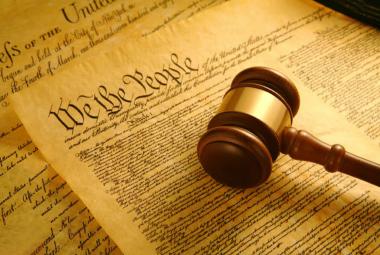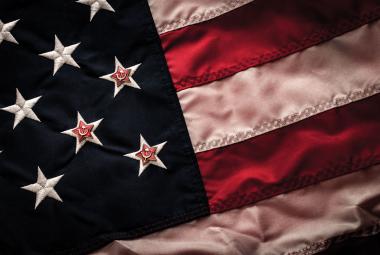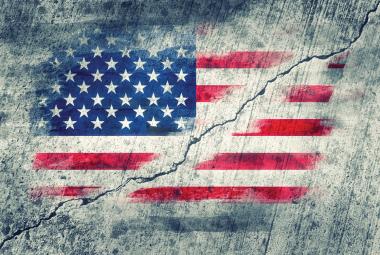The signers of the Declaration of Independence were certain that war would bring untold suffering and sacrifice at every level, but there was a prize worthy of giving their all—Liberty.
When in the Course of human events, it becomes necessary for one people to dissolve the political bands which have connected them with another, and to assume among the powers of the earth, the separate and equal station to which the Laws of Nature and of Nature’s God entitle them, a decent respect to the opinions of mankind requires that they should declare the causes which impel them to the separation.
The summer of 1776 was, in the words of Founder Thomas Paine, one of the “times that try men’s souls.” From the end of the Seven Years’ War in 1763 to the Declaration of Independence, the relationship of the American colonies with Great Britain had deteriorated severely.
An Increasing Tax Burden
In 1764, to help offset its huge war debt and the expenses of running the colonies, the English Parliament imposed the Sugar Act, which increased the duties on imported sugar, textiles, coffee, wines, and dyes. That was followed by the Currency Act, the Stamp Act of 1765, the Quartering Act, the Declaratory Act of 1766, and the Townshend Acts of 1767, all of which imposed heavy colonial taxes on imports and hardships on the citizens, which led to a groundswell of protests, boycotts, and simmering violence.
On March 5, 1770, the Boston Massacre occurred as a mob harassed British soldiers, who then fired their muskets pointblank into the crowd, killing five and injuring six.
To protest the Tea Act of 1773, which gave the British East India Company a monopoly to trade tea in America, the colonists refused to pay any import duties on the tea onboard the British ship Dartmouth, and on December 16 dumped all the tea into the Boston harbor in what has been called the Boston Tea Party.
An angry Parliament retaliated with the first of the Coercive or Intolerable Acts in 1774, placing Massachusetts under military rule and virtually ending any self-rule by the colonists. Many colonists saw this as a direct violation of the British Constitution and a threat to all their liberties.
The Loss of Liberty
By the time the First Continental Congress met in September 1774, the American colonies had been forced to endure taxation without representation, searches and seizures without probable cause, the confiscation of firearms, and the long list of other legal offenses detailed in the Declaration that Parliament had left unresolved.
Yet even when armed conflict in the Revolutionary War broke out on April 19, 1775, with “the shot heard around the world” on Lexington Green in Massachusetts, few colonists desired complete independence from Great Britain. Most were merely fighting for their rights as subjects of the British Crown.
Things changed over the course of the next year, however, as Britain’s great military force attempted to crush the rebellion. In August 1775, the king declared that the American subjects were “engaged in open and avowed rebellion.”
Then in February 1776, Parliament passed the Prohibitory Act, which established a blockade of American ports and declared American ships to be enemy vessels. The result of all these actions is perhaps best reflected in the words spoken by Thomas Jefferson on November 29, 1775:
Believe me, dear Sir: there is not in the British empire a man who more cordially loves a union with Great Britain than I do. But, by the God that made me, I will cease to exist before I yield to a connection on such terms as the British Parliament propose; and in this, I think I speak the sentiments of America.
Quest for Independence
In October 1775, to quell the rebellion, King George III ordered the enlargement of the royal army and navy. When this news reached America in January 1776, it propelled the cause for independence and led many colonists to abandon all hopes of reconciliation. In May, the Congress learned that the king had negotiated treaties with German states to hire mercenaries to fight in America. His actions convinced many Americans that England was now treating them as foreigners.
We hold these truths to be self-evident, that all men are created equal, that they are endowed by their Creator with certain unalienable Rights, that among these are Life, Liberty and the pursuit of Happiness.—That to secure these rights, Governments are instituted among Men, deriving their just powers from the consent of the governed,—That whenever any Form of Government becomes destructive of these ends, it is the Right of the People to alter or to abolish it, and to institute new Government, laying its foundation on such principles and organizing its powers in such form, as to them shall seem most likely to effect their Safety and Happiness.
Cutting Ties with Britain
When the Second Continental Congress first met in May 1775, King George III had not replied to the petition for redress of grievances sent by the First Continental Congress.
Therefore, the Congress gradually took on the responsibilities of a national government, and one by one began to cut the colonies’ ties to Britain. In June 1775, it established a continental currency as well as the Continental Army, appointing George Washington as its commander-in-chief, and in July created a post office for the “United Colonies.”
The Privateering Resolution, passed in March 1776, allowed the colonists to arm vessels to patrol and defend against “the enemies of these United Colonies.” On April 6, 1776, American ports were opened to commerce with other nations—an action that cut the economic ties dictated by Parliament’s Navigation Acts.
Uniting the Colonies
By mid-May 1776, eight American colonies had decided they would support independence, but Maryland, Pennsylvania, New York, New Jersey, and Delaware resisted. On May 15, 1776, Congress passed a set of resolutions drafted by John Adams that authorized the colonies to set up state governments independent of the Crown, and several did.
This was an emphatic act of sovereignty, and as such it necessitated a formal declaration of independence from the Crown. Four of the middle colonies voted against it, and the Maryland delegation walked out in protest. Also on May 15, the Virginia Convention passed a resolution that “the delegates appointed to represent this colony in General Congress be instructed to propose to that respectable body to declare the United Colonies free and independent states.” In keeping with these instructions, Richard Henry Lee of Virginia presented his resolution for independence on June 7:
Resolved: That these United Colonies are, and of right ought to be, free and independent States, that they are absolved from all allegiance to the British Crown, and that all political connection between them and the State of Great Britain is, and ought to be, totally dissolved.
There were still some stalwart delegates, however, who wished to pursue the path of reconciliation with Britain, and some threatened to leave Congress if the resolution was passed.
On June 10, Congress voted to postpone discussion of Lee’s resolution for three weeks of recess. However, before Congress recessed, a Committee of Five was appointed to draft a declaration of independence. During those final weeks of June 1776, support for a congressional declaration of independence was consolidated among the colonies.
Writing the Declaration of Independence
The Committee of Five, composed of John Adams, Benjamin Franklin, Thomas Jefferson, Robert R. Livingston, and Roger Sherman, instructed Jefferson to write the first draft. Jefferson’s most immediate sources were his own draft of the preamble of the Constitution of Virginia and George Mason’s Virginia Declaration of Rights, and he presented his “fair” draft to Benjamin Franklin and John Adams for their considerations and amendments prior to the presentation of a “rough draught” to the committee. They then presented this document to the Congress on June 28.
The Declaration is Officially Adopted: July 4, 1776
On July 2, 1776, after a great deal of wrangling and a powerful speech by John Adams, the resolution of independence was adopted with twelve affirmative votes and one abstention.
With this, the colonies officially severed political ties with Great Britain. On July 4, the final wording of the Declaration of Independence was approved and sent to the printer for publication. Then, at last, church bells rang out over Philadelphia declaring the Declaration had been officially adopted. Riders were sent in all directions with the news, and in many places it was celebrated with shouts and processions, with the firing of guns and the ringing of bells. Before long, the Declaration was read to audiences and reprinted in newspapers across the thirteen states.
We, therefore, the Representatives of the united States of America, in General Congress, Assembled, appealing to the Supreme Judge of the world for the rectitude of our intentions, do, in the Name, and by Authority of the good People of these Colonies, solemnly publish and declare, That these United Colonies are, and of Right ought to be Free and Independent States … For the support of this Declaration, with the firm reliance on the protection of the divine Providence, we mutually pledge to each other our Lives, our Fortunes, and our sacred Honor.
The Cost of Freedom
The people understood the enormous cost of the step they were taking. John Adams wrote to his wife regarding the meaning of his own signature on the document of freedom:
I am well aware of the toil, and blood, and treasure, that it will cost us to maintain this declaration. … I can see that the end is more than worth all the means, and that posterity will triumph in that day’s transaction.
He and his fellow signers of the Declaration were certain that war would bring untold suffering and sacrifice at every level, leaving empty chairs at family tables, widows, fatherless children, grieving mothers and fathers.
But there was, as Adams notes, a prize worthy of giving their all—Liberty—and there would be no king to stand in the way of it.






